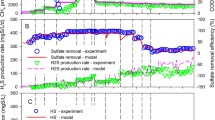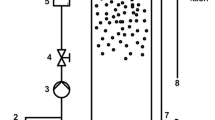Abstract
The existing mathematical models of sulphate fed anaerobic reactors are reviewed. Special attention was put on pecularities of the description of sulphide inhibition and competition between sulphate reduction and methanogenesis in such systems. The paper also presents an integrated mathematical model of the functioning of a sulphate fed granular sludge reactor taking into account concentration gradients on substrates, intermediates, products and bacteria inside the reactor as well as multiple-reaction stoichiometry and kinetics. The developed model includes the following blocks: a) hydrodynamic block describing liquid flow as well as transport and distribution of the components along the reactor height; b) kinetic block including growth, metabolism, inhibition and competition of acidogenic, acetogenic, methanogenic and sulphate reducing bacteria in the system; c) physico-chemical block for calculation of pH in each compartment of the liquid phase; d) transfer block describing a mass transfer of gaseous components from the liquid to the gas phase. The integrated model was calibrated and validated using laboratory studies on the functioning of sulphidogenic granular sludge reactors, i.e. their start-up and the maximisation of sulphide yield in these reactors. The modelling of the reactor operation is supplemented with hypothetical computer simulations to illustrate the influence of engineering parameters on the operation performance and sulphate conversion of sulphidogenic reactors.
Similar content being viewed by others
References
Alphenaar PA (1994) Anaerobic granular sludge: characterisation and factor affecting its functioning. PhD thesis, Wageningen Agricultural University, the Netherlands
Alphenaar PA, Visser A & Lettinga G (1993). The effect of liquid upward velocity and hydraulic retention time on granulation in UASB reactors treating waste water with a high sulphate content. Biores. Technol., 43: 249–258
Andrews JF (1969) A dynamic model of the anaerobic digestion process. J. Sanit. Engin. Div. ASCE 95-SA1: 95–110
Arcand Y, Chavarie C & Guiot SR (1994) Dynamic modelling of the population distribution in the anaerobic granular biofilm. Water Sci. Technol. 30(12): 63–73
Binot RA, Bol T, Naveau HT & Nyns EJ (1983) Biomethanation by immobilized fluidized cells. Water Sci. Technol. 15: 103–113
Bolle WL, van Breugel J, van Eybergen GC Kossen NWF & van Gils W (1986) An integral dynamic model for the UASB reactor. Biotechnol. Bioeng. 28: 1621–1636
Darton RC (1985) The physical behaviour of three-phase fluidized beds. In: Davidson JF, Clift R & Harrison D (Eds) Fluidization, 2nd Edition, (pp.495–528). Academic Press, New York
Desjardins B & Lessard P (1992) Modelling of anaerobic digestion process. Sci. Technol. EUA 25: 119–132
Fomichev AO & Vavilin VA (1997) The reduced model of self-oscillating dynamics in an anaerobic system with sulfate reduction. Ecol. Modelling 95: 133–144
Guiot SR, Pauss A & Costerton JW (1992) A structured model of the anaerobic granule consortium. Water Sci. Technol. 25(7): 1–10
Gupta A, Flora JRV, Sayles GD & Suidan MT (1994) Methanogenesis and sulfate reduction in chemostats-II. Model development and verification. Water Res. 28: 795–803
Hoeks FWJMM, Ten Hoopen HJG, Roels JA & Kuenen JG (1984) Anaerobic treatment of acid water (methane production in a sulphate rich environment). Progr. Ind. Microbiol. 20: 113–119
Isa Z, Grusenmeyer S & Verstraete W (1986) Sulphate reduction relative to methane production in high rate anaerobic digestion: technical aspects. Appl. Environ. Microbiol. 51: 572–579
Kalyuzhnyi SV (1997) Batch anaerobic digestion of glucose and its mathematical modelling. II. Description, verification and application of model. Biores. Technol. 59: 249–256
Kalyuzhnyi S & Fedorovich V (1997) Integrated mathematical model of UASB reactor for competition between sulphate reduction and methanogenesis. Water Sci. Technol. 36: 01–208
Kalyuzhnyi SV & Fedorovich VV (1998) Mathematical modelling of competition between sulphate reduction and methanogenesis in anaerobic reactors. Biores. Technol. 65: 227–242
Kalyuzhnyi SV, de Leon Fragoso C. & Rodriguez Martinez J (1997) Biological sulphate reduction in an UASB reactor fed with ethanol as electron donor. Mikrobiologiya 66: 687–693
Korn GA & Korn TM (1968) Mathematical handbook for scientists and engineers. McGrow Hill Book Company, New York, San Francisco, Toronto, London, Sydney
Lens P, de Beer D, Cronenberg CCH, Houwen FP, Ottengraf SPP & Verstraete WH (1993) Heterogeneous distribution of microbial activity in methanogenic aggregates: pH ang glucose microprofiles. Appl. Environ. Microbiol. 59: 3803–3815
Lens P, Visser A, Janssen A, Hulshoff Pol L & Lettinga G (1998) Biotechnological treatment of sulfate rich wastewaters. Crit. Rev. Environ. Sci. Technol. 28:41–88
Lettinga G (1995) Anaerobic digestion and wastewater treatment systems. Antonie van Leeuwenhoek 67: 3–28
Lettinga G, van Velsen VFM, Hobma SW, de Zeeuw WJ & Klapwijk A (1980) Use of the upflow sludge blanket (USB) reactor concept for biological wastewater treatment, especially for anaerobic treatment. Biotechnol. Bioeng. 22: 699–734
McCarthy DP & Oleszkiewicz JA (1991) Sulfide inhibition of anaerobic degradation of lactate and acetate. Water Res. 25: 203–209
Millne WI (1955) Numerical solution of differential equations, Inostrannaya Literatura, Moscow
Mulder A (1984) The effect of high sulphate concentrations on the methane fermentation of waste water. Progr. Ind. Microbiol. 20: 133–143
Narnoli SK & Mehrotra I (1997) Sludge blanket of UASB reactor: mathematical simulation. Water Res. 31: 715–726
O'Flaherty V & Colleran E (1995) Microbial interactions during the anaerobic treatment of sulphate containing waste waters. Med. Fac. Landbouw Univ. Gent: 60/4b, 2669–2676
Okabe S, Nielsen PH & Charaklis WG (1992) Factors effecting microbial sulfate reduction by Desulfovibrio desulfuricans in continuous culture: limiting nutrients and sulfide concentration. Biotechnol. Bioeng. 40: 725–734
Omil F, Lens P, Hulshoff Pol L & Lettinga G (1996) Effect of upward velocity and sulphide concentration on volatile fatty acid degradation in a sulphidogenic granular sludge reactor. Proc. Biochem. 31: 699–710
____ (1997) Characterization of biomass from a sulphidogenic, volatile fatty acid–degrading granular sludge reactor. Enzyme Microb. Technol. 20: 229–236
Omil F, Lens P, Visser A, Hulshoff Pol L. & Lettinga G (1998) Long-term competition between sulfate reducing and methanogenic bacteria in UASB reactors treating volatile fatty acids. Biotechnol. Bioeng. 57: 676–685
Oude Elferink SJWH, Visser A, Hulshoff Pol L & Stams AJM (1994) Sulfate reduction in methanogenic bioreactors. FEMS Microb. Rev. 15: 119–136
Overmeire A, Lens P & Verstraete W (1994) Mass transfer limitation of sulfate in methanogenic aggregates. Biotechnol. Bioeng. 44: 387–391
Parkin GF, Lynch NA, Kuo W-C, Van Keuren EL & Bhattacharya SK (1990) Interaction between sulfate reducers and methanogens fed acetate and propionate. J. WPCF 62: 780–788
Rabinovich VL & Havin ZYa. (1977) Short chemical handbook. Khimiya Press, Moscow
Reis MAM, Almeida JS, Lemos PC & Carrondo MJT (1992) Effect of hydrogen sulfide on growth of sulfate-reducing bacteria. Biotechnol. Bioeng. 40: 593–600
Rinzema A (1988) Anaerobic treatment of wastewater with high concentration of lipids and sulfate. PhD thesis, Wageningen Agricultural University, the Netherlands
Rinzema A & Lettinga G (1988). Anaerobic treatment of sulphate containing wastewater. In:Wize DL (Ed), Biotreatment Systems, Vol. III (pp. 65–109). CRC Press Inc., Boca Raton
Sam-Soon P, Wentzel MC, Dold PL, Loewenthal RE & Marais GvR (1991) Mathematical modelling of upflow anaerobic sludge bed (UASB) systems treating carbohydrate waste waters. Water SA 17: 91–106
Schwarz A, Yahyavi B, Mosche M, Burkhardt C, Jordening H-J, Buchholz K & Reuss M. (1996) Mathematical modelling for supporting scale up of anaerobic wastewater treatment in a fluidized bed reactor. Water Sci. Technol. 34(5/6): 501–508
Schwitzenbaum MS & Jewell WJ (1978) Anaerobic attached film expanded bed reactor for the treatment of dilute organics. Paper presented at 51th Ann. Water Pollut. Control Fed. Conf., Anaheim, California
Speece RE, Parkin GF, Bhattacharya S & Takashima S (1986) Trace nutrients requirements of anaerobic digestion. In: Proc. EWPCA Conf. 'Anaerobic treatment, a grown up technology', (pp. 175). Amsterdam
Stucki G, Hanselmann KW & Hurzeler RA (1993) Biological sulphuric acid transformation: reactor design and process optimization. Biotechnol. Bioeng. 41: 303–315
Van den Berg L & Kennedy KJ (1981) Support material for stationary fixed film reactors. Biotechnol. Lett. 3: 165–170
Van Houten RT, Hulshoff Pol LW & Lettinga G (1994). Biological sulphate reduction using gas-lift reactors fed with hydrogen and carbon dioxide as energy and carbon source. Biotechnol. Bioeng. 44: 586–94
Vavilin VA, Vasiliev VB, Rytov SV & Ponomarev AV (1994) Self-oscillating coexistence of methanogens and sulphate-reducers under hydrogen sulphide inhibition and the pH-regulating effect. Biores. Technol. 49: 105–119
____ (1995) Modeling ammonia and hydrogen sulphide inhibition in anaerobic digestion. Water Res. 29: 827–835
Visser A (1995) The anaerobic treatment of sulphate containing wastewater. PhD thesis, Wageningen Agricultural University, the Netherlands
Visser A, Beeksma I, Van der Zee F, Stams AJM & Lettinga G (1993) Anaerobic degradation of volatile fatty acids at different sulfate concentration. Appl. Microb. Biotechnol. 40: 549–556
Widdel F (1988). Microbiology and ecology of sulphate and sulphur-reducing bacteria. In: Zehnder AJB (Ed) Biology of anaerobic microorganisms (pp. 469–585). Wiley, New York
Wu MM & Hickey RF (1997) Dynamic model for UASB reactor including reactor hydraulics, reaction, and diffusion. J. Environ. Engin.-ASCE 123: 244–252
Young JC & McCarty PL (1969) The anaerobic filter for waste water treatment. J. Water Pollut. Control Fed. 41: R160–R173
Author information
Authors and Affiliations
Rights and permissions
About this article
Cite this article
Kalyuzhnyi, S., Fedorovich, V., Lens, P. et al. Mathematical modelling as a tool to study population dynamics between sulfate reducing and methanogenic bacteria. Biodegradation 9, 187–199 (1998). https://doi.org/10.1023/A:1008339018423
Issue Date:
DOI: https://doi.org/10.1023/A:1008339018423




